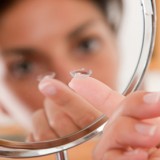Contact Lenses for Kids
Contact lenses for kids can be an important aspect of treatment for kids with special vision needs. While the idea may seem inappropriate to some, contact lenses for kids are relatively common. Contact lenses may even be used in infants with aphakia, or absence of an eye lens after cataract removal surgery. When considering contact lenses for kids, parents and guardians should ensure that the child is responsible enough to understand responsibilities and follow directions. In infants, parents and guardians should consider the severity of the child’s medical need.
Age for Contact Lenses
Many parents and medical professionals have dissenting opinions regarding the optimal age for contact lenses for kids. In an American Optometric Association (AOA) survey, roughly half of optometrists felt that ages 10 to 12 are most appropriate. Roughly one-quarter felt that 13 to 14 was an appropriate age range, and the remaining quarter was divided amongst the eight to nine age range and below age eight. It is important to consider that age ranges are variable. The most important factors to consider relate to each individual child.
Influencing Factors
There are a number of factors that may influence the use of contact lenses for kids. A study from the Ohio State University’s College of Optometry showed that children ages eight through 11 may experience improved self-perception while wearing contacts as opposed to glasses. This pattern was especially prevalent in young girls.
Other influencing factors may include, but are not limited to, the following:
- The child’s interest and motivation in wearing contact lenses
- The child’s maturity level
- The child’s ability to take care of lenses by himself or herself
- The child’s personal hygiene habits
- Whether or not the child participates in sports
- The intensity of the child’s prescription requirement
Contact Lens Maintenance
It is critical that kids with contact lenses practice proper hygiene and responsibility. A 2010 study in the journal Pediatrics examined children’s emergency room visits from medical device injuries and complications. Of the roughly 70,000 children observed, about one-fourth sought emergency attention for issues related to contact lenses. These issues included abrasions and infections due to poor responsibility and hygiene.
Kids with contact lenses should practice the following safety and hygiene precautions:
- Always washing hands before inserting or cleaning lenses
- Drying hands with a clean and lint-free cloth after washing
- Only using doctor-advised products and solutions for cleaning contact lenses
- Rubbing, rinsing, and disinfecting contact lenses only as directed
- Avoiding wearing contact lenses for too long
- Avoiding wearing contact lenses in an eye that is red or irritated
- Never wearing another individual’s contact lenses
- Seeking medical attention or advice for prolonged eye itching, irritation, or burning
- Applying makeup after lens insertion and removing lenses before removing makeup

















